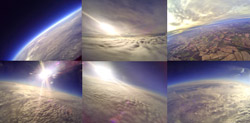ASTRA: Atmospheric Science Through Robotic Aircraft

Exploring Earth's atmosphere using high altitude unmanned instrument platforms<br>
The use of fleets of light, unmanned aircraft, makes extensive studies more affordable, even when payloads need to be delivered to extreme altitudes. It also enables applications where the deployment of manned aircraft is impractical, such as when observations need to be made in highly polluted environments (e.g., volcanic ash clouds) or extreme weather conditions.
The challenges of developing such system are of a highly multi-disciplinary nature, involving:
Aircraft design: the aircraft have to be able to operate in the harsh, low pressure, low density environment of the upper stratosphere, as well as in the dense and turbulent lower troposphere. Additionally, weight and power requirements of all on-board systems have to be minimized. The need to keep weight and cost to a minimum demands novel manufacturing technologies too.
Flight physics: efficient sampling of atmospheric parameters requires very careful design of the trajectories and flight control algorithms of the aircraft. This is an especially pressing requirement if unpowered gliders are used.
Software systems engineering: the real-time, often computationally intensive ground-based processing of large amounts of data collected by the sensors on board the aircraft is made especially challenging by the difficulties of data download from very high altitude platforms with low powered transmitters.
For more information, please email A. Sóbester, S. Johnston or J. P. Scanlan.
Media Contact
More Information:
http://www.soton.ac.ukAll latest news from the category: Information Technology
Here you can find a summary of innovations in the fields of information and data processing and up-to-date developments on IT equipment and hardware.
This area covers topics such as IT services, IT architectures, IT management and telecommunications.
Newest articles

Red light therapy for repairing spinal cord injury passes milestone
Patients with spinal cord injury (SCI) could benefit from a future treatment to repair nerve connections using red and near-infrared light. The method, invented by scientists at the University of…

Insect research is revolutionized by technology
New technologies can revolutionise insect research and environmental monitoring. By using DNA, images, sounds and flight patterns analysed by AI, it’s possible to gain new insights into the world of…

X-ray satellite XMM-newton sees ‘space clover’ in a new light
Astronomers have discovered enormous circular radio features of unknown origin around some galaxies. Now, new observations of one dubbed the Cloverleaf suggest it was created by clashing groups of galaxies….





















